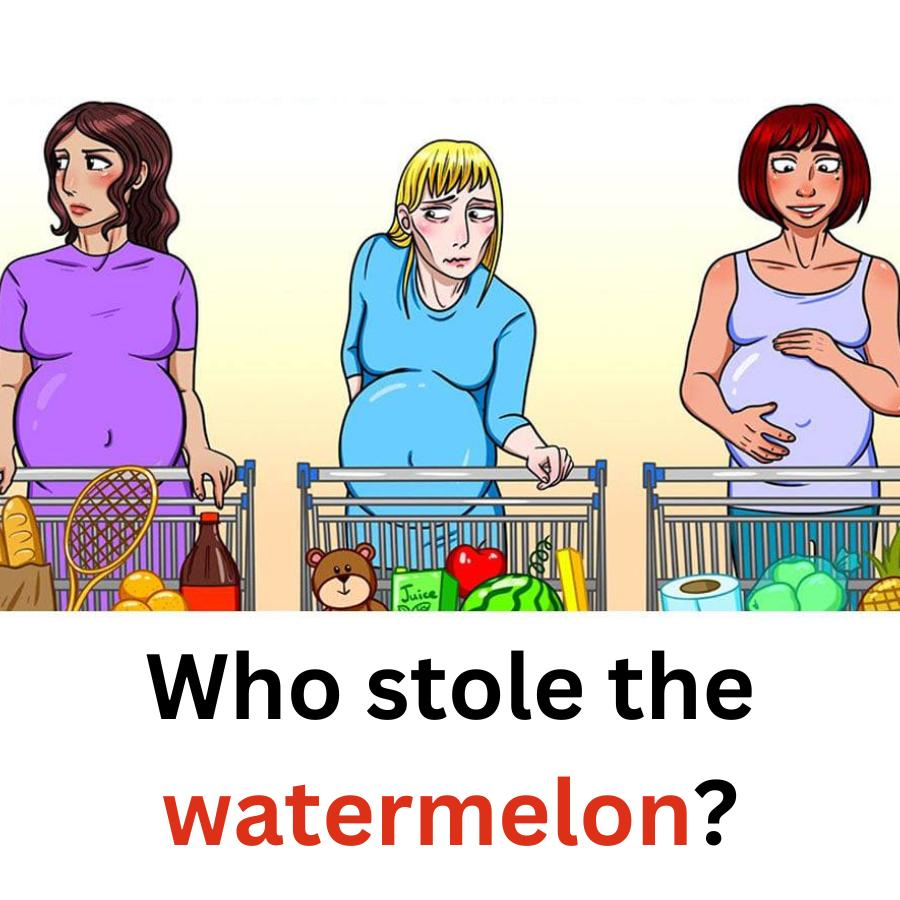Sometimes, a single image can spark debates, theories, and curiosity. The “Who stole the watermelon?” puzzle is one such example that combines humor, observation, and critical thinking. The question seems simple, but the answer lies in the details that challenge our assumptions. Let’s take a closer look at this clever puzzle, analyze the clues, and reveal why the answer points to the girl in purple.
The Puzzle: A Lighthearted Challenge

The image depicts three women, all seemingly pregnant, standing next to their shopping carts. The question posed: Who stole the watermelon? While the women appear to be expecting, the puzzle hints at deception. It’s a classic test of observation and logic, designed to make you question your initial impressions.
To unravel this riddle, we need to examine the image closely, focus on subtle details, and apply a bit of reasoning.
The Girl in Purple: A Suspicious Shopper
At first glance, all three women might appear to be innocent. However, the key to solving the puzzle lies in analyzing the contents of their shopping carts—and questioning the outward appearance of their “pregnancy.”
The girl in purple gives away the most telling clue. Her cart is filled with items that don’t align with the typical dietary choices of an expectant mother. Let’s break it down:
- Unusual Grocery Choices:
Her cart contains a tennis racket, soda, and oranges—none of which suggest a balanced or pregnancy-friendly shopping list. Compare this with the other women, whose carts are stocked with items like fruits, vegetables, and baby products. - The Deceptive Belly:
While the girl in purple appears pregnant, her stomach may actually be hiding the watermelon in question. The odd combination of items in her cart hints that her “pregnancy” might just be a cover for the theft.
Why Not the Other Women?
The other two women have shopping carts and appearances that align more closely with expectant mothers. Here’s why they’re less suspicious:
- The Girl in Blue:
Her cart contains baby-related items like juice, stuffed toys, and fresh produce. These items are consistent with someone preparing for a child, making her less likely to be the culprit. - The Girl in Lavender:
Her cart is filled with wholesome items like vegetables, toilet paper, and other essentials, which suggest practical and thoughtful preparation. Her demeanor and choices appear more natural.
Spotting the Subtle Clues
The brilliance of this puzzle lies in its ability to mislead at first glance. Our brains are wired to trust appearances, so it’s easy to overlook the small details that reveal the truth. In this case, the shopping cart contents and the slightly awkward “pregnancy” of the girl in purple give her away.
- Her Cart vs. Her Condition:
A genuine expectant mother would likely include items catering to her dietary needs or baby essentials. The girl in purple’s cart lacks these entirely, which makes her the prime suspect. - Behavioral Indicators:
While the other two women appear calm and composed, the girl in purple seems slightly uneasy. Her expression and body language may subtly hint at her guilt.
Why This Puzzle Is So Engaging
This type of visual riddle appeals to people because it combines observation with a dash of humor. It plays on assumptions, nudging viewers to think critically and challenge initial impressions.
- Visual Deception: The use of pregnancy as a disguise adds a layer of complexity. It forces us to question what we see and look deeper.
- Attention to Detail: The puzzle rewards those who notice the small, easily missed details, making it a satisfying challenge for keen observers.
Lessons from the Watermelon Thief
What can we learn from this fun, lighthearted puzzle? Here are a few takeaways:
- Don’t Trust Appearances:
Things aren’t always what they seem. This puzzle reminds us to look beyond the surface and question the obvious. - Attention to Detail Matters:
Whether in solving riddles or navigating real life, paying attention to small details can reveal the bigger picture. - Humor in Observation:
Even simple puzzles like this one can offer a good laugh and a reminder not to take things too seriously.
Conclusion: The Truth Revealed
The culprit in the “Who stole the watermelon?” puzzle is the girl in purple. Her suspicious shopping cart and unlikely “pregnancy” point to her as the one hiding the watermelon under her dress.
This clever riddle challenges our assumptions and encourages us to look closer at the details. Next time you encounter a puzzle like this, remember: the answer might not be as obvious as it first seems!